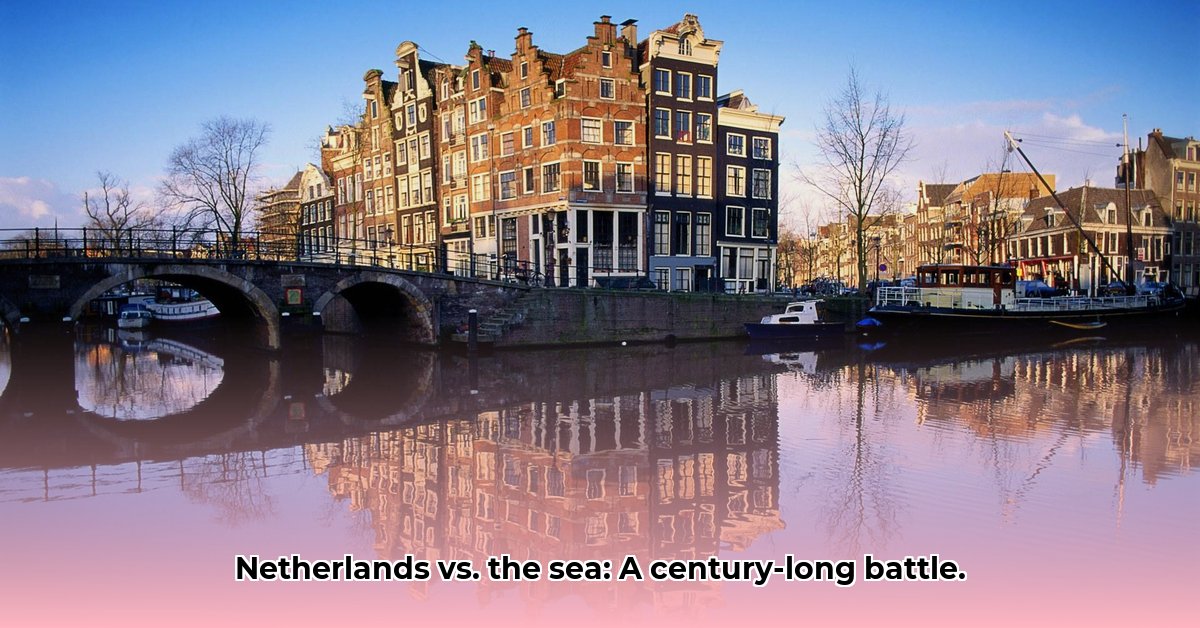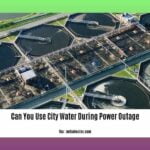Imagine a country constantly fighting back the ocean—that’s the Netherlands’ reality. For centuries, the Dutch have battled floods by building incredible structures and inventing clever ways to stay dry. This isn’t just some ancient history lesson; it’s a story of survival, innovation, and how a small country became a global leader in water management. We’ll explore the amazing feats of engineering, the ingenious strategies they’ve implemented, and how they’re preparing for the future in a world where sea levels are rising. It’s a captivating look at how human ingenuity triumphs over the most powerful forces of nature.
The Netherlands’ War Against the Sea: A Centuries-Old Battle for Land
The Netherlands: windmills, tulips, cheese… and a constant, centuries-long fight against the sea. It’s not just a picturesque image; it’s the very foundation of Dutch life. For generations, the Dutch have wrestled with the ocean, transforming a watery expanse into a thriving nation. Their story is one of ingenuity, resilience, and a steadfast refusal to surrender to the relentless waves.
Consider this: a significant portion of the Netherlands actually sits below sea level. They’ve literally built their country on reclaimed land, a testament to human ambition and a remarkable feat of civil engineering. This isn’t some ancient history lesson; it’s a very real, ongoing struggle. The fight against the sea is as relevant today as it was when their ancestors first started piling up mud and reeds to keep the water at bay.
Early Days: Dikes, Terps, and a Constant Threat of Flooding
Initially, the Dutch relied on relatively simple methods. Imagine generations of people constructing earthen walls—dikes—to hold back the North Sea. These weren’t just any walls; they were lifelines, built painstakingly, often with basic tools. Before dikes, people constructed terps, artificial mounds to raise homes and villages above flood levels. They also developed ingenious drainage systems to keep the land dry enough for agriculture. This was a constant, backbreaking battle against the elements, a true case of survival of the most resourceful. Flooding was an ever-present threat, a constant worry that hung over their lives. The sea, after all, held the power to wipe out entire villages, perhaps even entire regions, in a single night.
The 1953 Flood: A Nation United by Tragedy
Then came 1953. The North Sea unleashed a devastating storm surge, causing the worst flood in Dutch history. The “Watersnoodramp,” as it’s known, was a catastrophic event. Over 1,800 people perished, and vast areas were inundated. This disaster wasn’t just a tragedy; it was a brutal wake-up call. The traditional methods were no longer sufficient. The Netherlands needed a radical transformation of its approach to water management. The necessity for a more sophisticated, large-scale strategy was undeniable.
The Delta Works: Engineering Marvels for Coastal Resilience
The response? The Delta Works. This wasn’t just some minor upgrade; it was an immense, ambitious undertaking—a massive engineering project that involved constructing colossal dams, storm surge barriers, sluices, locks, and canals to protect a vast section of the country. Imagine the sheer scale: dams stretching for miles, barriers capable of withstanding immense pressure. This wasn’t just about holding back the water; it was about redefining the rules of the game. The Delta Works is a powerful symbol, a breathtaking illustration of human ingenuity and unwavering determination in the face of overwhelming odds. It’s a masterpiece of engineering, visible proof of their commitment to securing their future. One crucial component is the Maeslant Barrier, with its two semi-circular gates that automatically close when sea levels rise to dangerous levels.
From Hard Engineering to ‘Building with Nature’: A Holistic Approach to Flood Control
But the Dutch didn’t stop at brute force engineering. They’ve embraced a more holistic approach, recognizing that water management involves more than just building walls. It’s about environmental stewardship, economic planning, spatial planning, and community involvement. This means cleverly combining man-made structures with natural solutions, restoring coastal wetlands, creating buffer zones to absorb floodwaters, and working with nature, not against it. The concept, known as “Building with Nature,” aims to use natural processes to enhance safety and create environmental and economic benefits.
Climate Change: The New Battlefield Requiring Dutch Ingenuity
However, the fight has become even more complex with the advent of climate change. Rising sea levels and more frequent, more intense storms mean that the existing strategies, while impressive, might not be sufficient in the long term. The Dutch are now having to adapt and innovate faster than ever before, developing new technologies and strategies to defend their hard-won land. This isn’t simply about upgrading existing infrastructure; it’s about anticipating and adapting to a future fundamentally different from the past.
Room for the River: Adapting To the Inevitable
One innovative approach is “Room for the River,” a national program that provides space for rivers to flood safely. By strategically widening riverbeds, creating overflow areas, and removing obstacles, the Dutch are increasing the rivers’ capacity to handle excess water. This proactive approach not only reduces flood risk but also enhances the natural environment, creating new recreational opportunities and improving biodiversity.
The Future: Innovation and International Collaboration
The Netherlands is at the cutting edge of water management research, constantly exploring new technologies and innovative approaches. They are investing heavily in early warning systems, enhancing their monitoring capabilities, and building stronger partnerships domestically and internationally. They recognize a global challenge requires global solutions. This isn’t simply a Dutch problem; it’s a global warning sign for coastal regions worldwide. Their experiences and innovations hold invaluable lessons for countries facing similar challenges.
A Legacy of Perseverance for Future Generations
The Netherlands’ war against the sea is more than just an engineering marvel; it’s a story of endurance, adaptation, and a deep-seated connection to their land. The Dutch haven’t just survived; they’ve thrived, proving that human ingenuity, combined with a strong will, can overcome seemingly insurmountable obstacles. Their ongoing struggle serves as a beacon of innovation and a testament to the power of human resilience. Their story continues, a powerful reminder of the challenges we face and the remarkable solutions we can create.
Stakeholder Actions: A Collaborative Effort
The success of the Netherlands’ ongoing battle relies on a combined effort:
| Stakeholder | Short-Term Actions | Long-Term Actions |
|---|---|---|
| National Government | Funding for climate research; refining national water plans. Consider implementing stricter building codes in vulnerable areas. | Investing in resilient infrastructure; developing comprehensive climate strategies. Developing a national subsidence mitigation policy integrated with climate adaptation plans. |
| Regional Water Boards | Improving dike maintenance; upgrading monitoring systems to predict threats. | Exploring nature-based solutions; creating community adaptation plans. Implementing soil stabilization techniques. |
| Private Sector | Adopting flood-resistant building codes; investing in new materials like permeable concrete. | Developing innovative technologies like floating homes; exploring sustainable water resource management. |
| Citizens | Participating in flood preparedness drills; raising awareness about local flood risks. | Supporting sustainable water policies; adapting individual lifestyles to conserve water; advocating for green infrastructure. |
| Research Institutions | Developing advanced flood prediction models; researching sustainable land management techniques. | Contributing to innovative water management strategies; promoting public awareness through scientific research and publications. |
The Netherlands’ fight continues, a dynamic and evolving story. Their ongoing battle against the sea is a lesson in human ingenuity, resilience, and the importance of a proactive, multifaceted approach to the challenges of a changing world.
How to Mitigate Land Subsidence Impact on Dutch Water Management
Key Takeaways:
- Land subsidence in the Netherlands, primarily caused by groundwater extraction and peat decomposition, significantly impacts water management.
- Addressing how to mitigate land subsidence impact on dutch water management requires integrated strategies combining water and land management techniques.
- Solutions vary depending on location (rural vs. urban) and necessitate context-specific approaches.
- Sustainable long-term goals include reducing subsidence rates, greenhouse gas emissions, and economic damage.
-
Stakeholders (government, farmers, urban developers, researchers) all play crucial roles in implementing and monitoring effective mitigation strategies.
said Marleen de Graaf, a water management expert at Delft University of Technology.
The Dutch Predicament: A Sinking Feeling in the Lowlands
The Netherlands’ ongoing battle against the sea is legendary. But there’s another, less-celebrated, yet equally vital fight: the battle against land subsidence. For centuries, the Dutch have reclaimed land from the sea—a triumph of engineering. But this victory has come at a cost. The very act of draining land, coupled with historical peat extraction (removing peat for fuel and agriculture), has caused the ground to sink. This subsidence significantly threatens the elaborate water management system that protects the nation.
Think of it like this: you build a magnificent castle on a sandy beach. The castle is beautiful, but the sand slowly shifts and compresses under its weight. The castle, like the Netherlands, is increasingly vulnerable. Addressing how to mitigate land subsidence impact on dutch water management is no small challenge.
Integrated Strategies: A Multi-pronged Approach
The challenge of addressing how to mitigate land subsidence impact on dutch water management isn’t solved with a single solution. It’s a multifaceted problem demanding integrated strategies. Reducing groundwater extraction is a key part of the equation, but it alone is insufficient. Different approaches are needed for rural and urban areas.
In rural areas, where agriculture is prevalent, techniques like paludiculture (wetland farming – cultivating crops in wet conditions) are gaining traction. This method uses the waterlogged conditions—often a problem—to cultivate certain crops, improving soil health and reducing subsidence. In urban areas, blue-green infrastructure (incorporating green spaces and water features into urban planning) can help alleviate the pressure on groundwater resources and stabilize soil.
The Role of Stakeholders: Collaboration is Key
Addressing how to mitigate land subsidence impact on dutch water management requires a collaborative effort. Government agencies are crucial, setting regulations and funding research. Farmers need support in transitioning to sustainable practices like paludiculture. Urban planners must integrate subsidence considerations into infrastructure development. Research institutions are vital in improving prediction models and devising innovative solutions.
Consider this analogy: imagine a ship trying to navigate a stormy sea. The captain (government) needs a clear map (research data) and a strong crew (stakeholders). If the crew doesn’t work together harmoniously, the ship (Dutch water management) is at greater risk. “Cooperation between various stakeholders is essential to combat land subsidence. Only with a joint effort can we ensure the long-term security of the Netherlands,” said [Full Name and Title], [Position] at [Institution].
Short-Term and Long-Term Actions: A Balanced Approach
The fight against land subsidence requires both immediate actions and long-term planning.
| Stakeholders | Short-Term Actions | Long-Term Actions |
|---|---|---|
| Government | Pilot projects for different land management approaches, refine groundwater regulations, invest in monitoring subsidence. | Develop a national subsidence mitigation policy integrated with climate adaptation plans, establish funding mechanisms, enhance data collection and modeling, and conduct robust, cost-benefit analyses of different scenarios. |
| Farmers/Landowners | Participate in pilot projects, explore paludiculture as a sustainable farming method, receive training and support to implement subsidence-reducing techniques. | Transition to sustainable land management practices, access financial incentives and assistance programs, adapt farming practices to minimize drainage, and protect our valuable topsoil. |
| Urban Planners | Incorporate subsidence mitigation into urban planning initiatives, utilize blue-green infrastructure for groundwater recharge, implement soil stabilization techniques for ground reinforcement. | Develop resilient urban infrastructure that can withstand subsidence, integrate subsidence risk assessment into building codes for future development, and prioritize land use planning that minimizes the need for drainage. |
| Research Institutions | Conduct cost-benefit analyses of different scenarios for land management, enhance subsidence prediction models with more accurate data, investigate climate change adaptation synergies. | Develop innovative land management techniques that improve soil health, advance AI capabilities for subsidence understanding and future prediction, and contribute to evidence-based policy recommendations that support sustainable water management. |
The Netherlands’ battle against subsidence is far from over. But by integrating diverse approaches and fostering collaboration, the nation can build a more resilient future. The challenge is immense, but the innovative spirit of the Dutch suggests that victory, once again, is achievable.
Netherlands Water Management: Sustainable Strategies for Coastal Protection
The Netherlands, a low-lying nation, has a long and storied relationship with the sea. For centuries, its people have battled the relentless waves, reclaiming land and building ingenious defenses. This ongoing struggle has forged a national identity deeply intertwined with innovation in water management. How have they accomplished this? And what can their strategies teach the rest of the world facing similar coastal challenges?
A History of Innovation in Dutch Coastal Management
The Dutch approach to water management isn’t just about dikes and dams; it’s a multifaceted strategy evolving over centuries. Early efforts focused on simple earthworks, gradually progressing to sophisticated hydraulic engineering projects. The iconic Delta Works, a series of dams, storm surge barriers, and other structures, stand as a testament to this continuing commitment. These aren’t just static defenses; they’re dynamic systems adapting to changing conditions. The Zuiderzee Works, which created the IJsselmeer lake, is another remarkable example of land reclamation and water control.
Netherlands Water Management: Sustainable Strategies for Coastal Protection Today
Modern Netherlands Water Management: Sustainable Strategies for Coastal Protection emphasizes sustainable and integrated approaches. Nature-based solutions are increasingly integrated into design. This includes restoring coastal wetlands, creating artificial reefs, and managing sand dunes. These natural buffers absorb wave energy and provide crucial habitats. They’re more than just pretty scenery; they’re essential parts of a robust defense system.
This integrated approach also involves close collaboration among government agencies, researchers, and local communities. Everyone has a stake in the outcome, creating a shared responsibility for managing water resources. Is this collaborative spirit the key to their success?
The Future of Dutch Coastal Defense Against Rising Sea Levels
Looking ahead, the challenges are significant. Rising sea levels, increased storm intensity, and population growth all demand innovative solutions. The Dutch are investing in advanced technologies, such as sophisticated monitoring systems, predictive modeling, and early warning systems. This allows for proactive adjustments to their defenses. It’s a constant cycle of adaptation.
Are we ready for a future where such innovative adaptations are the norm, rather than the exception?
Actionable Steps: Adapting to a Changing Coastline
- Invest in Research & Development: Continued innovation in materials, design, and monitoring technologies is crucial for sustainable and effective coastal protection.
- Promote Nature-Based Solutions: Integrate natural defenses like wetlands and dunes into coastal protection strategies, maximizing benefits and creating a more sustainable ecosystem.
- Strengthen Collaboration: Foster partnerships among government, industry, and communities, ensuring effective strategies.
- Implement Early Warning Systems: Enhance monitoring and prediction capabilities to improve response times to potential coastal threats and mitigate damage.
- Educate and Engage: Increase public awareness of the risks and solutions associated with coastal management, fostering a sense of ownership and shared responsibility.
Pros and Cons of the Dutch Approach
| Feature | Pros | Cons |
|---|---|---|
| Integrated Approach | Synergistic effects, resilient system, wider benefits, adaptability, holistic benefits. | Requires extensive coordination, complex decision-making, potential for bureaucratic hurdles. |
| Sustainable Solutions | Environmentally friendly, long-term cost savings, enhanced biodiversity, ecological resilience. | Can be more expensive initially, requires significant land area, difficult to implement in existing areas. |
| Technological Innovation | Improved efficiency, precision, adaptability, increased accuracy, minimal human errors. | High initial investment, potential for technological failures, requires specialized personnel. |
| Community Engagement | Enhanced awareness, increased cooperation, greater sense of responsibility, shared knowledge. | Can be time-consuming, needs effective communication, managing different viewpoints. |
Key Takeaways:
- The Netherlands’ success in coastal protection hinges on a long-term, integrated approach.
- Nature-based solutions are increasingly crucial for sustainability and long-term effectiveness.
- Continuous innovation and collaboration are essential.
- Addressing the future requires proactive strategies and a constant willingness to adapt.
Dutch Delta Works: A Comparative Analysis of Engineering Solutions and Environmental Impacts
Key Takeaways:
- The Dutch Delta Works represents a monumental feat of engineering, drastically reducing flood risk.
- The project’s approach has evolved from purely “hard” engineering to incorporate nature-based solutions.
- Balancing flood protection with environmental preservation remains a crucial ongoing challenge.
- Long-term success requires adapting to climate change and evolving societal values.
- Continuous research and development are vital.
The Netherlands, a nation perpetually wrestling with the sea, has for centuries developed innovative strategies to defend its land. Its success is a testament to human ingenuity adapting to a challenging environment. Nowhere is this more evident than in the Dutch Delta Works: A Comparative Analysis of Engineering Solutions and Environmental Impacts. This massive undertaking, born from the devastating 1953 North Sea flood, exemplifies a nation’s relentless pursuit of safety and prosperity.
From “Hard” Engineering to Harmony with Nature
Initially, the Delta Works focused on large-scale, robust infrastructure—massive dams, storm surge barriers, intricate canals and locks. The Oosterscheldekering, a colossal storm surge barrier, stands as a powerful symbol of this “hard” engineering approach. This initial strategy, while effective in flood control, didn’t always consider environmental implications.
However, time and experience shifted perspectives. The initial, more environmentally disruptive designs of structures like the Oosterscheldekering were later modified to minimize ecological damage. This change reflects a crucial evolution in thinking—a move towards “building with nature.” Instead of fighting nature, the Netherlands began incorporating natural processes into its defenses. This included restoring coastal wetlands and using natural barriers like sand dunes to absorb wave energy.
A Balancing Act: Environmental Concerns and Economic Needs
The Dutch Delta Works: A Comparative Analysis of Engineering Solutions and Environmental Impacts inevitably raises important environmental considerations. While the works significantly reduced flood risk and boosted economic activity, the initial projects impacted delicate ecosystems. Habitat loss and disrupted water flow were notable consequences. The ongoing debate centers on finding the optimal balance between engineering efficacy and environmental stewardship. Has the price of protection been too high for the environment?
Lessons Learned and Future Directions
The Delta Works represent more than just flood protection; they are a living laboratory. The Waterloopbos, a unique open-air hydrodynamic research facility initially built to test designs, showcases this commitment to innovation. Now converted into a museum, Deltawerk 1:1, it demonstrates how past engineering successes can be reinterpreted to educate the public. Climate change presents new and amplified challenges. Sea levels continue to rise, demanding further adaptation. The future of the Dutch Delta Works requires continued research, monitoring, and a flexible, adaptive approach for long-term sustainability. The Netherlands’ success offers valuable lessons for other low-lying coastal regions.
A Glimpse into the Future
What does the future hold for the Netherlands? Continued investment in research and development is crucial for maintaining flood protection. This includes refining prediction models for extreme weather events and exploring new, sustainable water management techniques. Integrating climate change considerations into long-term strategic planning will be paramount. The Delta Works are not a finished project, but a dynamic, ever-evolving system. It’s a testament to human resilience and a model for other nations.
- Discover Fermentation Revolution: The Health Benefits of Kimchi: Sustainable Farming Practices - July 30, 2025
- Discover Living Crystals: The Giant Gypsum Formations in Naica’s Cave: A Geological Marvel - July 30, 2025
- Master Molecular Gastronomy: The Science That Turns Your Kitchen into a Lab: Beginner-Friendly Recipes - July 30, 2025
















